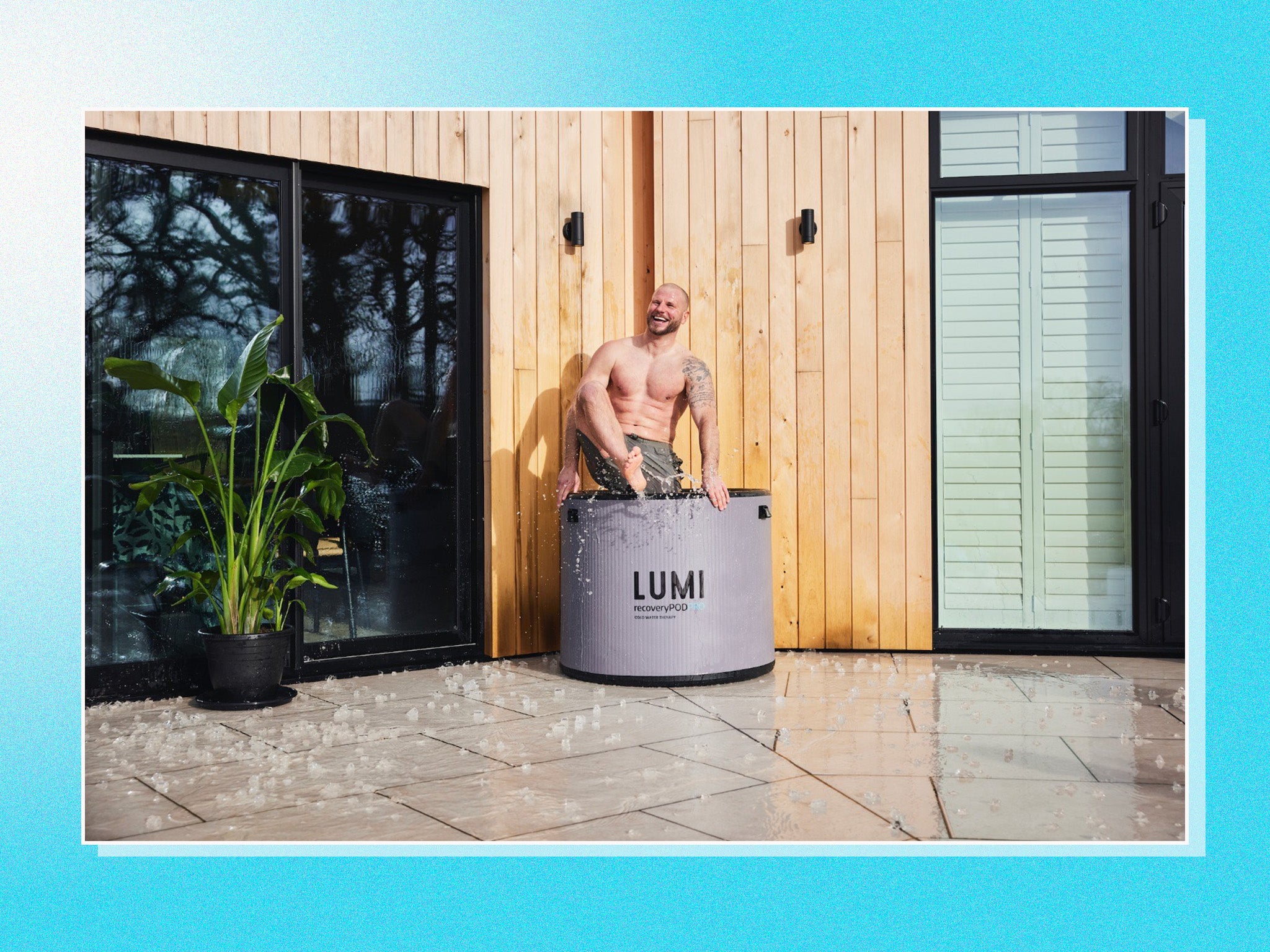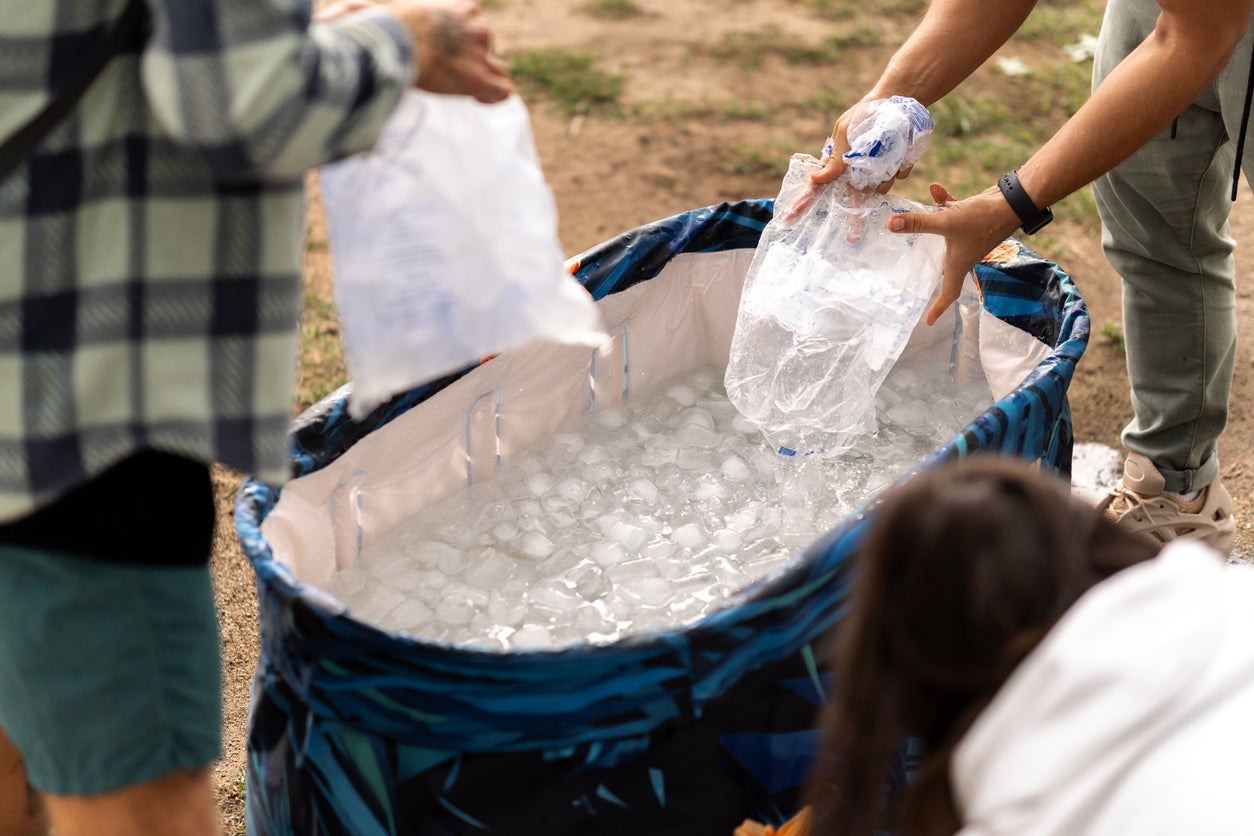Should you use an ice bath? Experts take a deep dive into the pros and cons of cold water therapy
Two experts share their reasons for and against taking the plunge

Ice baths are like Marmite in the wellness world. Supporters swear by daily dips for a range of mental and physical health benefits, while naysayers claim the perks of cold water therapy are overhyped.
What’s not up for debate is the meteoric rise of ice baths in recent years. Though bathing in ice and related cryotherapy practices have been documented as far back as 3500 BCE, a decade ago you’d struggle to find someone who owned their own prefab tub. Whereas nowadays, thousands of people across the UK start their day with a glacial dunk. Indeed, it’s hard to scroll through Instagram without seeing some friend, family member or vague acquaintance lowering themselves into a low-temperature tub.
But is this trendy display of stoicism worth the hassle? To find out, we spoke to two experts on the topic; Dr Matthew Maley, a lecturer in environmental ergonomics (focussing on how environmental factors impact health and performance) at Loughborough University, and Gavin Teague, founder of ice bath and recovery brand Lumi Therapy.
Below, they explain how to start using an ice bath, as well as the benefits and drawbacks you might expect to see from doing so.
What is the difference between an ice bath and cold water therapy?
Before we take the plunge, it’s important to make a distinction between ice baths and cold water therapy.
“They’re not exactly the same,” Dr Maley explains. “An ice bath is specifically when you submerge yourself in water with ice, usually between 0°C and 15°C. Cold water therapy basically means exposing your body to cold water on purpose. It’s a broader term than just ice baths, and includes stuff like using cold compresses, hopping in a cold shower or even open water swimming – in the UK at least.
“The effects and how you use them can be different depending on the method. For example, a cold shower might perk you up by providing mental stimulation, while an ice bath is usually used for post-workout recovery or reducing inflammation.”
Is an ice bath good for you?
This is the big question. The short answer for most people is yes, to some extent; current research suggests there are a number of benefits to regularly using an ice bath.
“The evidence at the moment suggests cold therapy practices may promote physical health by improving cardiovascular function and reducing inflammation, and support mental wellbeing by alleviating stress and enhancing mood,” Dr Maley says.
When used as part of a recovery routine, they can help reduce swelling, ease pain, boost circulation and flush out metabolic byproducts, he adds.
“This all happens because the cold triggers physiological responses, like constricting your blood vessels and slowing down nerve conduction.”
However, it’s the mental health benefits that Teague prefers to focus on for ice bath users. Having spent three minutes in a 3°C ice bath every day for a year, he believes that if someone commits to the practice for a month: “I would put my life on the fact that their life will completely change.”
“The discipline it takes to do 30 days of an ice bath will change your whole mindset, not just how you feel,” he continues. “It’s the ultimate reset in the morning. How many people wake up and feel groggy, tired, or like they’ve had a bad sleep? [An ice bath] eliminates all of that. And off the back of that, the discipline it creates means you end up being so much more disciplined in every aspect of life.”
Dr Maley doesn’t disagree with this latter point, adding: “In terms of discipline and resistance, anything can work for this if people believe it enough, i.e. the placebo effect.”
Teague also points to research which links cold water immersion to elevated dopamine levels for several hours afterwards. This is a hormone which as been associated with improved mood, attention and motivation.
“Dopamine does increase during cold exposure,” Dr Maley agrees. “It then starts to reduce when removed from cold, so it’s a temporary response. And it does certainly make you more awake temporarily, but a brisk 15-minute walk will do something similar.”

What are the disadvantages of ice baths?
The best-documented disadvantage of ice baths is that having one immediately after strength training can hamper muscle growth.
“Studies have shown that cold water immersion after lifting weights can slow down muscle growth and strength gains in the long run,” says Dr Maley. However, he adds, the occasional ice bath won’t hurt.
Teague agrees, and advises people whose main fitness goal is building muscle to leave at least two hours between their lifting session and having an ice bath, or jump in first thing in the morning before they hit the gym.
Dr Maley also says there are several groups who should talk to their doctor before jumping into ice baths.
“Spending too long in cold water can lead to hypothermia, where your core temperature is less than 35°C. Older adults and anyone with trouble regulating their body temperature will be more prone to hypothermia, so they should be cautious.
“There are also some cardiovascular risks, like a sudden spike in blood pressure or an increased chance of irregular heartbeats. So people with heart conditions, especially those with unstable conditions, irregular heart rhythms or high blood pressure, should be extra cautious too.”
For other forms of cold water therapy such as open water swimming, there are further precautions to consider.
“Some people jumping in the sea on a hot day in early spring or summer could be at risk as the sea is still cold in the UK,” Dr Maley says. “There would be a dramatic reduction in skin temperature leading to something called a ‘cold shock response’, which is responsible for many deaths and drownings. Cold shock is characterised by hyperventilation when exposed to cold water.
“People could also be exposing themselves to risks of non-freezing cold injuries. This is a condition that is often underreported in the literature, but occurs when skin temperature falls below approximately 15°C for a protracted period. This condition can lead to pain at night in the afflicted periphery and leads people to be more susceptible to frostbite. Non-freezing cold injury is also more prevalent in individuals of black African descent.”
How long are you supposed to stay in an ice bath?
Teague recommends starting slowly and spending a very short amount of time in slightly warmer water to begin with.
“Start off with anything under 15°C, then just get in and get out,” he advises. “That’s more than enough to get a feeling of what it’s like. Then leave it for the day, and don’t put too much pressure on yourself.
“Each day, try to increase the time and build up to 30 seconds. The first challenge is whether you can stay in for 30 seconds to have a chemical reaction in the body. After that it’s whether you can stay in for a little bit longer to have a mental challenge, so you can become more stoic and control your nervous system. Or to find out if you can control your breathing in stressful environments.”
Teague also suggests gradually lowering the temperature as you go, and experimenting with what feels good for you.
“Take it slowly – everyone’s different, and it’s just cold water. There’s no right or wrong. Anything under 15 degrees and anything over 30 seconds is enough. After that it’s up to the person; how cold and how long they want to go for? Although we never recommend over three or four minutes [so your core temperature doesn’t drop too low].”
However, there is one guiding principle he recommends sticking to when deciding how long to stay in an ice bath.
“If you’ve started to feel good in the ice bath, all the work is done. You’ve done the challenge, the body’s reaction has happened, and you’ve managed to control yourself in an ice bath. And it’s as simple as that. Stay in for as long as it takes for you to feel good, and when it feels good, get out.”
Verdict: Should you use ice baths?
If you’re intrigued by ice baths and don’t fall into any of the camps who ought to be cautious when using one (listed above by Dr Maley), go for it.
Existing research points towards several benefits, including reduced inflammation, improved heart health, lessening of stress and improved mood.
Many users also sing the praises of their subjective effects. For example, Teague says using one every day for a year helped him stay free from illness, fight anxiety and develop a discipline which improved his clarity of thought in day-to-day decision making.
“There wasn’t a single time that I got out and I didn’t feel better than when I got in,” he tells me. “Even if it was marginal, when times were really tough, I still felt better every single time.”
However, research into the benefits of ice baths and cold water therapy remains relatively limited.
“The existing evidence for cold water therapy, while promising, is less consistent than hot heat therapy studies and primarily based on non-randomised control trial studies with limited sample sizes,” says Dr Maley. “Some findings are based on self-reports.”
On this evidence, spending some time in the sauna or trying contrast therapy – a mix of hot and cold exposure – could be a worthwhile alternative for many people.
It’s also worth recognising that every body is different, and each person will respond to an ice bath in a slightly different way – we don’t all like or loathe Marmite, after all.
If you don’t fancy jumping cold water every day, you don’t have to, and you can stay perfectly healthy without doing so.




Bookmark popover
Removed from bookmarks